What Makes a Graphic Recording Successful?
The graphic recorders at bikablo bildwerk experience it every day: every job goes differently – and usually not as planned. A good example is Birgit Jansen’s recording of the Federal Office for Vocational Education and Training’s “Mobility Day 2019”. We asked her: What does it take for the picture to be seen as successful and for the process to be fun as well?
by Susann Figueredo Hechavarria
What Makes a Graphic Recording Successful?
SHARE ARTICLE
“Mapping different perspectives with a clear focus.”
Dear Birgit, Please start by telling us a bit about this event.
The organizer described the event as follows; “The Mobility Day 2019 showcased international opportunities in vocational education in the chemical sector, but also highlighted the commitment of companies and schools in the Erasmus+ program.” So it was all about experience abroad in vocational education. Participants were apprentices, vocational school teachers and personalities from business, politics and education.
You managed to create a great graphic recording for this event. It is lively, full of content, rich in detail and yet clearly structured and concise.
Thank you for the compliments! Indeed, in our recordings, the viewer should be able to quickly grasp the big picture and the structure of the content, connect emotionally to the information through individually illustrated moments, and of course also see the facts and figures. The fact that we succeeded here is mainly due to good preparation and cooperation with the client.
It is important for me to work with a clear focus. In this project, that meant reflecting the different perspectives: entrepreneurs emphasized the added value of an employee who had matured personally and professionally as a result of the stay abroad. The parliamentary state secretary emphasized the opportunity that looking beyond cultural borders brings in times of nationalistic coldness. The trainees, on the other hand, gave very concrete accounts of the everyday challenges they faced abroad, which they overcame independently to grow as personalities.
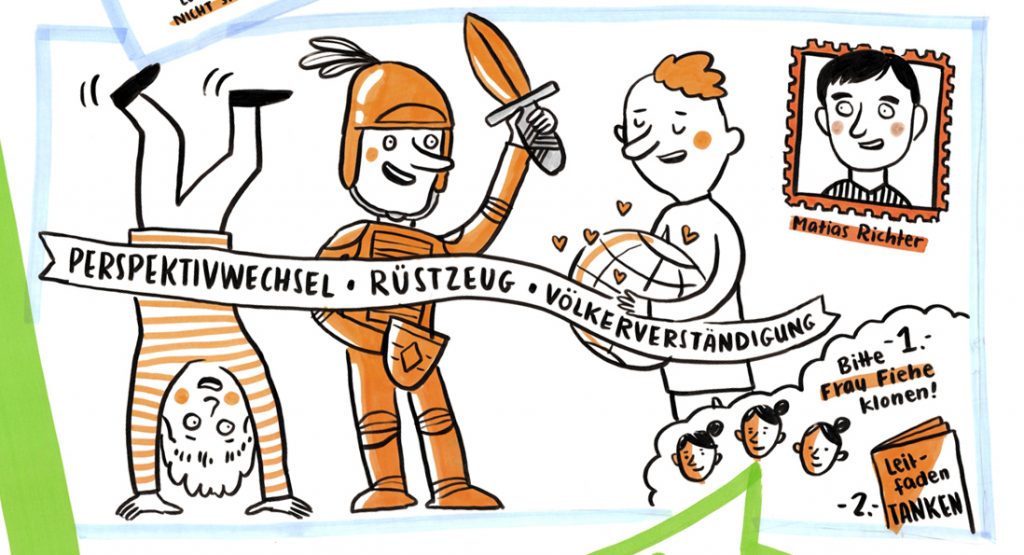
The topic seems to be very complex. What was important for you to clarify in the assignment so that you could go into the event well prepared?
Above all, I was able to build on the great foundation laid by my colleague Andrea Biesler as bildwerk project manager. Together with the client, she designed a coherent approach for the planned event, for example, with guiding questions to better understand the goals of the event and to be able to offer customized visual accompaniment. Every project is different: sometimes an analog graphic recording in large format is the best fit, sometimes its several individual images in small format, sometimes its a digital recording on the iPad, and sometimes it’s an accompaniment by a visualizing co-presenter. Only through a focused, collaborative exploration of the client’s intent can we offer the right visual intervention. In this case, a large recording that is created analogously to the dialogue process and whose creation is visible to all present.
Based on this preliminary work, I can then work on the content. In my detailed telephone briefing with the clients, it turned out that (in view of the previously mentioned perspectives) the personal, narrative moments of the trainees abroad should be the core of the day. After all, it was the organizers’ declared goal to inspire trainees without any experience abroad to emulate them through authentic reports of the globetrotters’ experiences. They were then framed by statements from business and politics. The intention behind this was to convey to the trainees that a stay abroad is also worthwhile in terms of a professional career and also socio-politically.
For me, a thematically coherent image analogy is a powerful skill in graphic recording. In the clarification of the assignment, the theme of “travel” emerged as a narrative-creative thread: in my imagination, the reports of experiences were embedded in the visual framework of a diary with open pages and the lectures as postcards draped around them.
What conditions at the event itself made this result possible?
Depending on the start of the event and the travel conditions, an evening arrival and a relaxed start to the day of the event proved to be the best solution. In this way, I was able to clarify any last minute questions in the morning, e.g. about the exact wording. It’s also always important for me to have a contact person on site who can help me with technical terms or background information during the process, and who I can always invite to take a quick “look over my shoulder”.
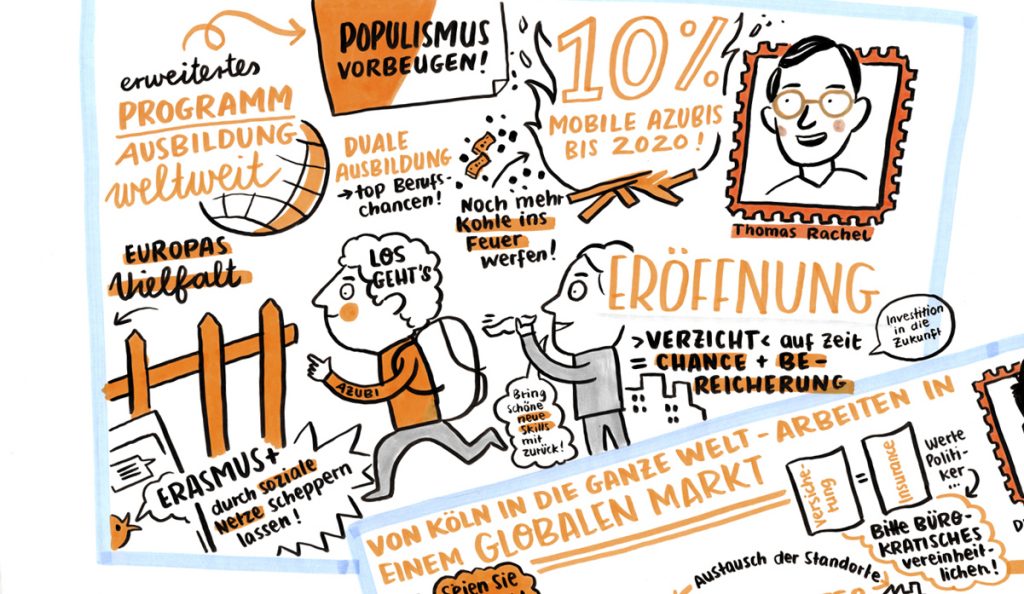
How do you come up with your clever image ideas that illustrate the content? Do they emerge during the process or is that part of your preparation?
Just as I am in awe of the achievements of simultaneous translators, participants often wonder where I get my image ideas from in live recordings. It helps that as an illustrator, graphic designer and graphic recorder, I have a large library of possible image stories and metaphors in my head. I often spontaneously incorporate the ideas of those present or do a little image research on my smartphone for certain abstract terms.
But here, too, preparation in terms of content is important. For the Bochum Citizens’ Conference 2019 on the topic of transport, for example, I went through all the different types of transport that I could think of – from the tandem bike to the pedelec to the subway – and drew them with my pen, so that I would not stumble in the drawing process.
And last but not least: the more lively and structured the people at a conference present their content, the simpler it is to transfer ideas into visuals. Visual formulations and concept anchors provide me with wonderful templates for image ideas that the participants can then recognize and recall.
Of course, the question remains as to how the finished recording can be used as meaningfully as possible in the further process. But we’ll save that for the next blog post. Thank you very much for the interview!
MORE ARTICLES ON THIS TOPIC
You Might Also Be Interested In...
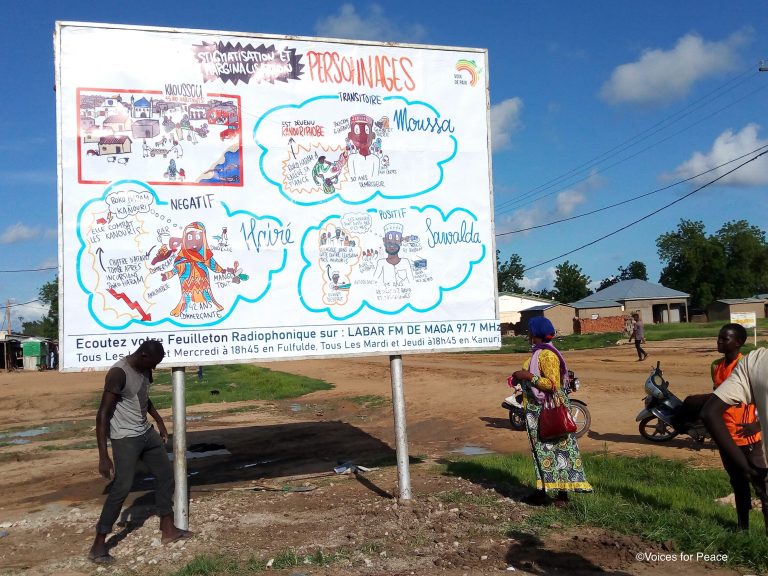
How to create an educational radio soap with a pencil
Interview with visualizer Filippo Buzzini of ‘Sketchy Solutions’, who helped us with a project in West Africa.
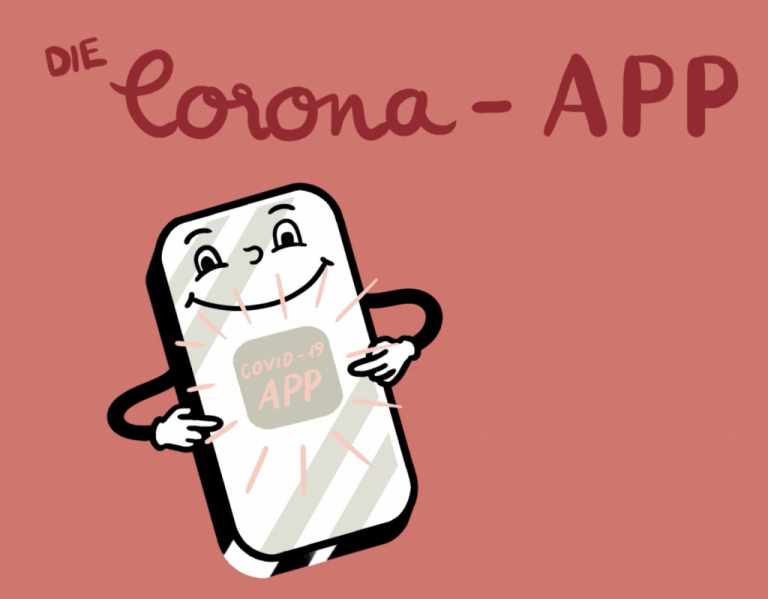
The new Corona warning app in the explanatory film
With this animated explanatory film, we at bikablo would like to show how the federal government’s “Corona warning app” works, why it was developed, which technologies it uses (and which it doesn’t), and what role data protection plays.
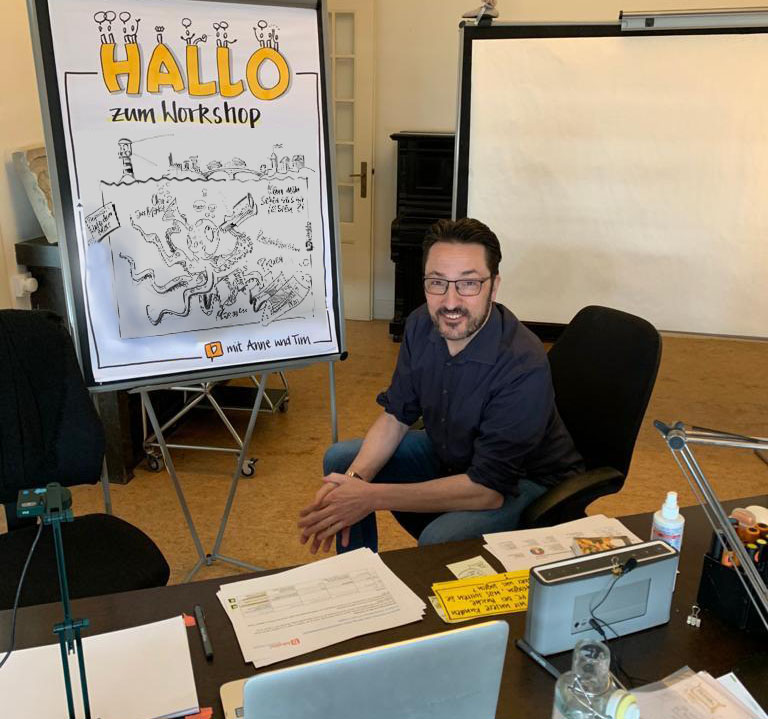
The digital grab bag
A strategy image workshop spontaneously switched to online by bikablo bildwerk enabled surprising insights: Here are the five most important takeaways on virtual collaboration.